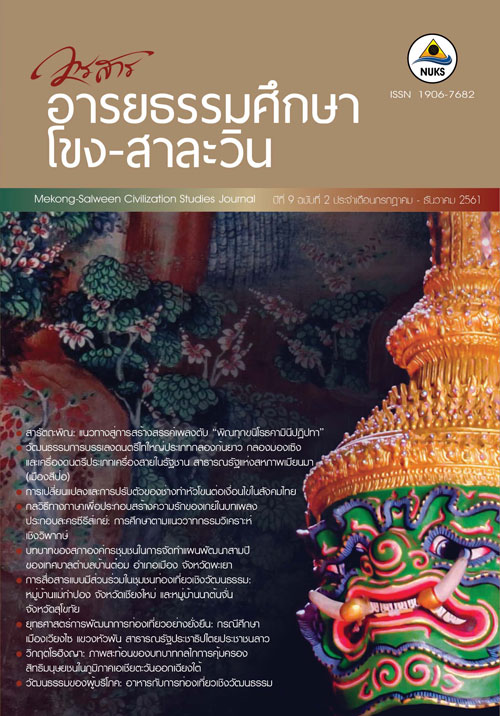Participatory Communication in the Cultural Tourism Communities: Maekampong Village, Chiang Mai Province and Na Ton Chan Village,Sukhothai Province การสื่อสารแบบมีส่วนร่วมในชุมชนท่องเที่ยวเชิงวัฒนธรรม: หมู่บ้านแม่กำปอง จังหวัดเชียงใหม่ และหมู่บ้านนาต้นจั่น จังหวัดสุโขทัย
Main Article Content
Abstract
This research has objectives of 1) Studying about process of participatory communication in the cultural tourism community, Mae kam pong Village, Chiang Mai Province and Na Ton Chan Village, Sukhothai Province; 2) Comparing process of participatory communication of both cultural tourism communities; 3)Development guidelines for participatory communication of cultural tourism community. This piece of work is a qualitative research using in-depth interviews, focus group discussion and participation observation in Mae kam pong Village, Chiang Mai Province and Na Ton Chan Village, Sukhothai Province
The results of the research is divided into 3 period, is the start period, operation period and the period to maintain. It was found that: 1) participatory communication process in cultural tourism community, Mae kam pong Village, in the starting period, the researcher used informal communication, having direction of communication in type of communication from top to bottom. Contests are emphasis on making income and development of public utilities. During operation period, the researcher used formal communication and informal communication. The communication has direction in horizontal and top to bottom directions. In maintenance period, the researcher used group communication, having multi-direction. Contents are emphasis on solving of outsider capitalists. In cultural tourism community, Na Ton Chan Village, in the starting period, the formal used was informal communication, top to bottom; the contents emphasized making income from OTOP products; In operation period, using formal and informal communication, horizontal and top to bottom; in maintenance period; using group communication, multi-direction, contents emphasized problem solving in the community; 2) Comparing participatory communication, it was found that formal and communication direction of communities were the same; there were different contents in tourism community; Mae kam pong Village, in the starting period, emphasis was on making income and development of public utilities; in maintenance period, emphasis was on solving problems of outsider capitalists of tourism community, Na Ton Chan Village, in the starting period, the emphasis was on development of woven fabric put into clay mud which was OTOP product of the community. In the maintenance period, emphasis was on solving problems inside the community and 3) Guidelines for development of participatory communication of cultural tourism community should be divided into three phases as follows: phases 1, Communication for giving information, used the informal communication format, having direction in type of top to bottom; phases 2 consultative communication with villagers. Communication format was in type of formal communication and informal communication, having horizontal direction and bottom to top; phases 3 Group communication has multi-direction, decentralizing the communication to every villager in the community so that villagers will participate in communication.
Downloads
Article Details
References
Grey-Felder. (2005). Who Measures Change? An Introduction to Participatory Monitoring and Evaluation of Communication for Social Change. CFSC Consortium Inc. Retrieved from https:// www.communicationforsocialchange.org/pdf/who_ measures_ change_pdf
Karnjana Sanglimsuwan. (2555). Sustainable cultural heritage tourism. Executive Journal. 32(4),139 -146.
Kheerajit Cherdpong. (2013). Participatory Development Communication for Natural Resources Management in Ratchaburi Province, Thailand. E-journal of Applied Procedia - Social and Behavioral Sciences, 103, (703-709). Retrirved from https://ac.els- cdn.com/S1877042813038354/1-s2.0- main.pdf?_tid=ae35311a-0a28-11e8-9ec5-00000aacb35 ce87986af61728c440ef243c9e72f4e6
Mefalopulos, Paolo. (2003). Theory and Practice of Participatory Communication: The Case of the FAO Project Communication for Development in Southern Africa. (Doctoral dissertation, Doctor of Philosophy). University of Texas, USA. Retrieved from https://www.lib.utexas.edu/etd/d/2003/.../mefalopulosp039.pdf
Nair, K.S. & White, (1993). Participatory communication: Working for Change and Development. New Delhi: Sage Publication.
Qasmi, Hosai. (2013). Building Solidarity and Social Cohesion through Participatory Communication in Afghanistan: A case Study of the National Solidarity Program. (Doctoral dissertation, Doctor of Philosophy). University of Ottawa, Canada. Retrieved fromhttps://www.ruor.uottawa.ca/handle/10393/26130?locale=fr
Servaes, Jan.& White. (1996). Participatory Communication for Social Change. New Delhi: Sage Publication.
Thomas, Pradip. (2004). Participatory communication for social change. California: Sage Publication.
Tufte,T., & Mefaloputlos, P. (2009). Participatory communication: A practical guide. Washington D.C.: The World Bank.

